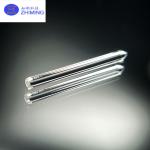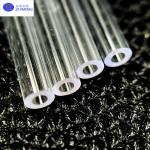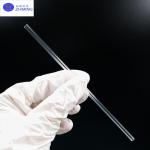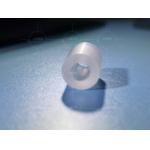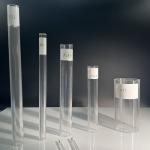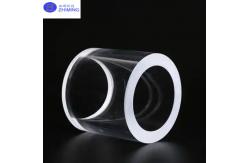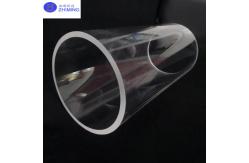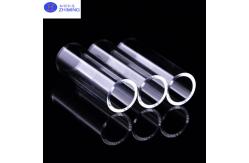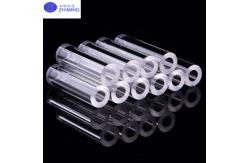Sapphire tube EFG double side polish for Laser and Optical Systems
Abstract
Sapphire tubes manufactured using the EFG (Edge-defined Film-fed
Growth) method and polished on both ends are emerging as a key
component in advanced laser and optical systems. Renowned for their
exceptional durability, optical clarity, and resistance to extreme
environments, EFG sapphire tubes are becoming the go-to choice for
engineers and designers requiring high-performance transparent
materials. These tubes offer a unique combination of mechanical
hardness, thermal stability, and broad-spectrum transparency,
making them ideal for applications ranging from high-power lasers
to semiconductor processing chambers. In this article, we explore
the defining features, benefits, and real-world uses of double-side
polished EFG sapphire tubes.
Sapphire Tube's Properties
Sapphire (single crystal aluminum oxide, Al₂O₃) is one of the
hardest and most chemically stable materials available for optical
components. When fabricated into a tube using the EFG method and
then double-end polished, it gains a set of properties particularly
suited for high-precision industrial and scientific applications.
1. Exceptional Hardness
Sapphire ranks 9 on the Mohs hardness scale—second only to diamond.
This extreme hardness ensures that sapphire tubes are
scratch-resistant and maintain their surface integrity even under
mechanical wear.
2. High Optical Transparency
EFG sapphire tubes offer excellent transmittance in a wide spectral
range—from deep ultraviolet (around 150 nm) to mid-infrared (up to
5.5 µm). This broad-spectrum clarity makes them suitable for
various optical and laser-based applications.
3. High Temperature Resistance
Sapphire can withstand temperatures up to 2000°C in a vacuum
environment, making it one of the best materials for
high-temperature laser and optical systems.
4. Excellent Chemical Stability
Sapphire is chemically inert and resists corrosion from most acids,
alkalis, and solvents, including hydrofluoric acid and plasma
environments, which is why it's a top choice in semiconductor
fabrication.
5. Superior Thermal Conductivity
Compared to most optical glass, sapphire has better thermal
conductivity, ensuring efficient heat dissipation in high-power
systems.
6. Optical Surface Polish (Double Side)
The double-side polish enhances both clarity and flatness, reduces
scattering, and enables precise integration with sealing or bonding
systems. It also improves the laser-induced damage threshold (LIDT)
for high-power optics.
Sapphire Tube’s Applications
The unique blend of optical and mechanical properties gives
sapphire tubes an edge across a range of industries. Here are some
of the most common application areas:
1. Laser Systems
EFG sapphire tubes are used in laser beam delivery systems,
especially for high-power lasers such as fiber lasers, CO₂ lasers,
and solid-state lasers. Their transparency and damage resistance
allow for stable and precise beam transmission in harsh operating
environments.
Protective Windows: In laser welding or cutting systems, sapphire
tubes can serve as protective sleeves for lenses and sensors.
Cooling Channels: In diode laser systems, they may serve as
transparent conduits for coolant flow, combining optical monitoring
with thermal regulation.
2. Optical Instruments
Sapphire tubes are often used in high-precision optical setups
requiring long-term stability and clarity under environmental
stress.
Spectroscopy and Sensing: These tubes are ideal in Raman
spectrometers or fluorescence detection systems where high optical
clarity is essential.
Fiber Optics and Light Guides: Polished sapphire tubes can act as
light pipes in fiber optic assemblies or as alignment sleeves for
optical connectors.
3. Semiconductor Equipment
The semiconductor industry demands materials that withstand
reactive gases and high temperatures. Sapphire tubes meet these
requirements:
CVD/MOCVD Reactor Chambers: As part of plasma-facing components,
they resist etching and particle generation.
Observation Windows: EFG sapphire tubes serve as transparent sight
glasses for visual monitoring inside vacuum chambers.
4. Medical and Life Sciences
In life sciences, sapphire’s biocompatibility and optical
properties make it suitable for specialized devices:
Flow Cells in HPLC: Sapphire tubes are used in high-pressure liquid
chromatography where chemical resistance and transparency are
crucial.
Endoscopic Instruments: Their scratch resistance and clarity allow
for high-definition imaging in medical diagnostics.
5. Aerospace and Defense
Sapphire tubes are employed in harsh aerospace environments, such
as:
Missile Optical Domes: Due to their strength and thermal
resistance.
Sensor Protection: For protecting optical sensors against sand,
wind, and thermal shock.
Real Product Photos and Manufacturing Insight
In the above image, you can see a series of high-purity EFG
sapphire tubes that have been polished to optical standards on both
ends.
The tubes demonstrate:
Perfect Cylindrical Symmetry: Ensures consistent beam propagation
and mechanical fit.
Uniform Inner and Outer Diameters: Enables precise alignment in
optical assemblies or pressure vessels.
Crystal Clarity: Highlighting the quality of both the raw material
and polishing technique.
Customization Options:
Outer Diameter: Typically from 3 mm to 100 mm.
Wall Thickness: From 0.5 mm to 10 mm.
Length: Up to 300 mm or more on request.
Orientation: Random or specified (C-axis, A-axis, etc.) for
birefringence-sensitive applications.
Polishing Grade:
Why Choose EFG Double-Polished Sapphire Tubes?
The EFG method allows the direct growth of hollow tubes,
eliminating waste and enabling tighter control over dimensions.
Combined with precision double-sided polishing, this fabrication
approach guarantees high-performance parts with:
Cost-effectiveness for mass production.
Repeatability for consistent system integration.
Longevity even in the most challenging environments.
When compared to traditional glass or quartz tubes, sapphire not
only outperforms in strength and durability but also offers
superior optical and thermal properties that justify its use in
mission-critical applications.
Conclusion
EFG sapphire tubes with double-side polish represent the pinnacle
of material engineering for modern laser and optical applications.
Their unmatched combination of hardness, optical transmission,
thermal resistance, and chemical stability makes them indispensable
in industries where precision, performance, and durability are
paramount. Whether you're developing a cutting-edge laser system,
building sensitive scientific instruments, or engineering
components for aerospace environments, sapphire tubes are a
reliable and forward-looking choice.
For custom sizes, coating options, and bulk pricing, feel free to
contact our technical sales team. We offer full OEM support, fast
lead times, and global shipping.
Q&A
Q: What is a sapphire tube and what is it used for?
A: A sapphire tube is a cylindrical component made from synthetic
sapphire (single-crystal aluminum oxide, Al₂O₃), known for its
exceptional hardness, high optical clarity, and resistance to heat
and chemicals. Sapphire tubes are commonly used in laser systems,
optical instruments, semiconductor processing equipment, and
medical devices. Their transparency across a broad spectrum (UV to
IR), as well as their durability in extreme environments, make them
ideal for high-precision and high-stress applications.
